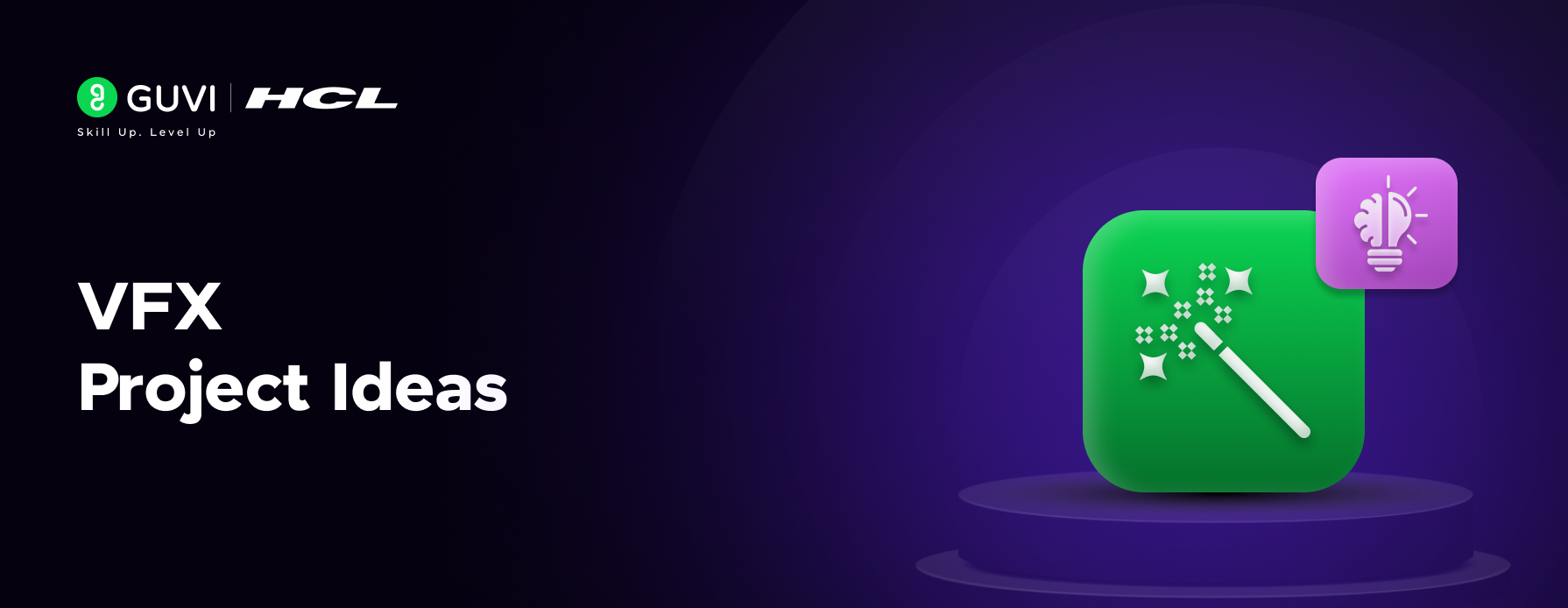![Top 10 Pattern Recognition Project Ideas [2025] 1 Post thumbnail](https://www.guvi.in/blog/wp-content/uploads/2024/04/Feature-image-1.png)
Top 10 Pattern Recognition Project Ideas [2025]
Jun 20, 2025 7 Min Read 10573 Views
(Last Updated)
Pattern recognition is an important component of artificial intelligence, enabling technologies like facial recognition and voice assistants. This field offers vast opportunities for innovation, particularly through practical projects. Engaging in pattern recognition projects can sharpen your skills and deepen your understanding across various applications.
In this blog, we’ll explore 10 exciting pattern recognition project ideas, from image classification to anomaly detection. Each idea is tailored to challenge your skills and apply your knowledge to real-world scenarios. Let’s explore these projects and discover the potential of pattern recognition!
Table of contents
- What is Pattern Recognition?
- Top 10 Pattern Recognition Project Ideas
- Image Classification Projects
- Speech Recognition Projects
- Financial Trend Analysis Projects
- Biometric Authentication Projects
- Natural Language Processing (NLP) Projects
- Health Monitoring Projects
- Environmental Pattern Recognition Projects
- Retail and E-commerce
- Anomaly Detection Projects
- Advanced Robotics Projects
- Conclusion
- FAQs
- What skills are necessary for a pattern recognition project?
- How do I select the right dataset for my pattern recognition project?
- What are common challenges in pattern recognition projects?
What is Pattern Recognition?
Pattern recognition is a branch of machine learning that focuses on the identification of patterns and regularities in data. It involves teaching machines to recognize patterns and make predictions or decisions based on the input data without human intervention. Here’s a breakdown of what this involves:
- Data Analysis: Pattern recognition systems analyze data to identify significant patterns or features that differentiate one kind of data from another. These patterns can be visual, auditory, textual, or numerical.
- Feature Extraction: This step involves extracting distinguishing characteristics or features from raw data. These features simplify the raw data into a form that is easier to analyze and process by a machine learning model.
- Model Training: Algorithms are trained on data sets to learn these patterns. The training process involves providing an algorithm with large amounts of data so it can learn what different patterns look like and how they differ from one another.
- Classification or Clustering: Once trained, the pattern recognition algorithms can classify new objects or data points into predefined categories (classification) or group new data points together based on similarity (clustering).
Pattern recognition is used in numerous applications, including speech recognition, image analysis, biometric identification, and more, allowing for automation and improvements in efficiency and accuracy across various fields.
Also Read: Machine Learning Must-Knows: Reliable Models and Techniques
Interested in mastering design patterns? Enroll in GUVI’s Design Pattern course and learn how to structure your software projects for maximum efficiency and scalability. Start your journey and elevate your coding skills with expert guidance. Transform your programming approach today!
Now that we understand what pattern recognition is, let’s explore 10 exciting project ideas to put this technology into action.
Top 10 Pattern Recognition Project Ideas
This list of top 10 pattern recognition project ideas covers a broad spectrum of applications, demonstrating the versatility and importance of this technology across various fields:
1. Image Classification Projects
Image classification uses pattern recognition to analyze and categorize visual data within images. This technology is integral to a variety of applications, including medical diagnostics, autonomous vehicle navigation, and facial recognition security systems.
By training models on extensive datasets with labeled images, algorithms, especially convolutional neural networks (CNNs), learn to detect and interpret complex patterns and features in visual inputs.
This capability allows systems to recognize objects, classify them, and even respond to visual stimuli in real time, making it a foundational skill in computer vision and artificial intelligence research.
Projects
A. Handwritten Digit Recognition using MNIST Dataset
Develop a system to recognize handwritten digits using the MNIST dataset, applying convolutional neural networks for high accuracy in image classification tasks.
Features
- Uses the popular MNIST dataset for benchmarking
- Utilizes CNNs for robust feature extraction
- Involves image preprocessing techniques such as scaling and normalization
- Employs dropout and pooling layers to improve model generalization
- Test accuracy using a split of training and test data
![Top 10 Pattern Recognition Project Ideas [2025] 2 Handwritten Digit Recognition using MNIST Dataset](https://www.guvi.in/blog/wp-content/uploads/2024/05/Image-1-1.png)
B. Facial Recognition with Deep Learning
Implement a facial recognition system using deep learning techniques to identify and verify individuals from images and video streams.
Features
- Applies real-time face detection and recognition
- Uses deep learning frameworks like TensorFlow or PyTorch
- Incorporates face alignment and normalization for improved accuracy
- Handles variations in face orientation and lighting conditions
- Employs privacy and security measures to protect biometric data
![Top 10 Pattern Recognition Project Ideas [2025] 3 Facial Recognition with Deep Learning](https://www.guvi.in/blog/wp-content/uploads/2024/05/Image-2-1.png)
Also Read: Best Data Science Books to Learn in 2025
2. Speech Recognition Projects
Speech recognition technology enables the conversion of spoken language into text by identifying and processing language patterns. This field is important for developing interactive voice-responsive systems, such as virtual assistants, hands-free controls, and automated transcription services.
Modern speech recognition systems utilize advanced machine learning models like recurrent neural networks (RNNs), that are capable of handling sequential data and capturing temporal relationships within speech.
The ongoing development in this area aims to improve accuracy, reduce latency, and expand the system’s ability to understand diverse accents and dialects, enhancing user interaction across various devices and platforms.
Projects
A. Building a Simple Speech-to-Text System
Create a speech-to-text transcription service using RNNs to convert spoken audio into written text, aiming for high accuracy and real-time processing.
Features
- Utilizes RNNs to process time-series audio data
- Includes noise reduction techniques to improve clarity
- Implements context-aware processing to enhance accuracy
- Integrates with APIs for real-time speech processing
- Adapts to various languages and accents
![Top 10 Pattern Recognition Project Ideas [2025] 4 Speech-to-Text System](https://www.guvi.in/blog/wp-content/uploads/2024/05/Image-3-1.png)
B. Voice Command Recognition for Smart Devices
Develop a voice command recognition system that allows users to control smart devices through spoken instructions, using pattern recognition to interpret and execute commands.
Features
- Recognizes basic voice commands like ‘play’, ‘stop’, ‘turn on/off’
- Employs advanced signal processing for clear audio capture
- Integrates seamlessly with IoT devices for practical usability
- Features low-latency processing for near-instantaneous response
- Provides robust performance in noisy environments
![Top 10 Pattern Recognition Project Ideas [2025] 5 Voice Command Recognition for Smart Devices](https://www.guvi.in/blog/wp-content/uploads/2024/05/Image-4-1.png)
Also Read: Best Books to Learn Machine Learning
3. Financial Trend Analysis Projects
Financial trend analysis utilizes pattern recognition to forecast future financial market behaviors by examining historical data. This approach is important for developing predictive models that assist investors and financial analysts in making informed decisions. Analysts can identify and capitalize on market trends by applying machine learning algorithms like time series analysis and regression models.
The complexity of financial markets requires robust and adaptable models that can handle the inherent volatility and randomness of market movements. Enhancing these models with the latest advancements in AI helps improve prediction accuracy and risk management, essential for algorithmic trading and strategic financial planning.
Projects
A. Stock Price Prediction Models
Predict stock price movements by analyzing historical market data with LSTM neural networks to provide investors with actionable insights.
Features
- Analyzes long-term trends using LSTM networks
- Incorporates multiple indicators like price and volume
- Utilizes real-time data feeds for up-to-date analysis
- Applies risk assessment techniques to mitigate potential losses
- Features back-testing against historical data to validate models
![Top 10 Pattern Recognition Project Ideas [2025] 6 Stock Price Prediction Models](https://www.guvi.in/blog/wp-content/uploads/2024/05/Image-5-1.png)
B. Algorithmic Trading Strategies based on Pattern Analysis
Develop automated trading strategies that use machine learning to identify and act on market opportunities, enhancing profitability and efficiency.
Features
- Uses pattern recognition to predict optimal trading points
- Integrates with trading platforms for real-time execution
- Employs statistical analysis for strategy optimization
- Includes stop-loss and take-profit parameters to manage risks
- Backtest strategies to ensure robustness and reliability
![Top 10 Pattern Recognition Project Ideas [2025] 7 Algorithmic Trading Strategies based on Pattern Analysis](https://www.guvi.in/blog/wp-content/uploads/2024/05/Image-6-1.png)
4. Biometric Authentication Projects
Biometric authentication systems use unique physiological or behavioral characteristics, such as fingerprints, iris patterns, or voiceprints, for secure user identification and access control. These systems rely on pattern recognition algorithms to accurately and efficiently match biometric data against stored profiles.
The use of biometrics is increasingly prevalent in areas requiring high security, such as mobile payments, border control, and restricted access facilities. Advancements in this field focus on enhancing the accuracy, speed, and scalability of biometric systems, as well as addressing challenges related to privacy, data integrity, and anti-spoofing measures.
Projects
A. Fingerprint Analysis System
Create a fingerprint-based identification system using image processing and neural networks to verify identities quickly and accurately.
Features
- Captures high-resolution fingerprint images
- Utilizes edge detection and minutiae extraction techniques
- Employs neural networks for feature matching
- Incorporates anti-spoofing measures to prevent fraud
- Ensures data encryption for secure storage and transmission
![Top 10 Pattern Recognition Project Ideas [2025] 8 Fingerprint Analysis System](https://www.guvi.in/blog/wp-content/uploads/2024/05/Image-7-1.png)
B. Iris Recognition for Secure Authentication
Implement an iris recognition system for high-security authentication, utilizing pattern recognition to analyze unique iris features for precise and reliable identity verification.
Features
- Uses high-definition cameras for iris image capture
- Applies radial segmentation to isolate the iris
- Features robust algorithms for pattern matching
- Integrates live detection to enhance security against fakes
- Provides rapid processing for user convenience
![Top 10 Pattern Recognition Project Ideas [2025] 9 Iris Recognition for Secure Authentication](https://www.guvi.in/blog/wp-content/uploads/2024/05/Image-8-1.png)
5. Natural Language Processing (NLP) Projects
Natural Language Processing (NLP) bridges the gap between human communication and computer understanding, enabling machines to process and interpret human language in a way that is both meaningful and useful. NLP encompasses a range of techniques from syntactic parsing and semantic analysis to sentiment analysis and machine translation.
These applications are critical in enhancing user experiences, streamlining business processes, and making information more accessible. NLP relies heavily on pattern recognition to identify linguistic structures and derive insights, which are important in applications such as chatbots, predictive typing, and content recommendation systems.
Ongoing research and development aim to overcome challenges related to language diversity, sarcasm, contextuality, and ambiguity.
Projects
A. Sentiment Analysis of Social Media Posts
Analyze sentiments expressed in social media posts to gauge public opinion and emotional trends, using machine learning models to classify text content accurately.
Features
- Processes large volumes of social media data
- Utilizes NLP tools for text analysis and preprocessing
- Employs supervised learning models for sentiment classification
- Analyzes trends over time to track sentiment shifts
- Integrates with social media APIs for real-time data retrieval
![Top 10 Pattern Recognition Project Ideas [2025] 10 Sentiment Analysis of Social Media Posts](https://www.guvi.in/blog/wp-content/uploads/2024/05/Image-9-1.png)
B. Email Spam Detection System
Develop an automated system to filter and classify emails as spam or legitimate, using pattern recognition to enhance email security and user productivity.
Features
- Uses text classification techniques to detect spam
- Implements machine learning algorithms like SVM and Naive Bayes
- Features automatic updating of spam filters based on new data
- Reduces false positives to avoid misclassification
- Offers user feedback integration to improve accuracy
![Top 10 Pattern Recognition Project Ideas [2025] 11 Email Spam Detection System](https://www.guvi.in/blog/wp-content/uploads/2024/05/Image-10-1.png)
Ready to master machine learning? Enroll in GUVI’s Machine Learning Course today and transform your career with cutting-edge skills. Start learning now!
6. Health Monitoring Projects
Health monitoring through pattern recognition involves the analysis of medical data to detect anomalies, predict outcomes, and provide personalized health insights. This technology is applied in wearable devices, diagnostic tools, and remote monitoring systems to improve patient care and health outcomes.
Pattern recognition helps in identifying early signs of diseases, monitoring chronic conditions, and predicting health trends based on data collected from a variety of sources, including biometric sensors, electronic health records, and genetic profiles.
The challenges in this field are vast, ranging from data privacy and security to the integration of diverse data types and ensuring the reliability and accuracy of health predictions.
Projects
A. Predictive Models for Disease Outbreaks
Utilize historical health data and current trends to develop models that predict potential disease outbreaks, aiding in proactive public health responses.
Features
- Integrates epidemiological data for pattern analysis
- Uses machine learning to identify potential outbreak signals
- Features real-time data updating for current relevance
- Applies geographic information systems (GIS) to track spread patterns
- Offers simulations to test and improve model predictions
![Top 10 Pattern Recognition Project Ideas [2025] 12 Predictive Models for Disease Outbreaks](https://www.guvi.in/blog/wp-content/uploads/2024/05/Image-11.png)
B. Real-Time Health Monitoring with Wearable Tech
Implement a health monitoring system using wearable technology to continuously track and analyze health indicators, providing real-time insights and alerts.
Features
- Monitors vital signs like heart rate and blood pressure
- Utilizes data analytics for trend analysis and anomaly detection
- Integrates with mobile devices for user accessibility
- Provides personalized health reports and recommendations
- Ensures data privacy with secure transmission protocols
![Top 10 Pattern Recognition Project Ideas [2025] 13 Real-Time Health Monitoring with Wearable Tech](https://www.guvi.in/blog/wp-content/uploads/2024/05/Image-12.png)
Must Explore: Top 9 Machine Learning Project Ideas For All Levels [with Source Code]
7. Environmental Pattern Recognition Projects
Environmental pattern recognition plays an important role in monitoring and predicting ecological and atmospheric changes. This field utilizes data from various sources, such as satellite imagery, sensor networks, and historical weather records, to forecast environmental conditions and inform conservation efforts.
The ability to recognize and interpret environmental patterns helps in predicting weather events, managing natural resources, and mitigating the impacts of climate change. Advanced machine learning models, including neural networks and decision trees, are employed to analyze complex datasets and provide accurate predictions.
The integration of real-time data and the development of scalable solutions are ongoing challenges that drive innovation in environmental monitoring.
Projects
A. Climate Change Prediction Models
Develop predictive models to forecast changes in climate variables, using historical data and machine learning to support environmental policy-making and public awareness.
Features
- Analyzes historical climate data and current trends
- Utilizes advanced machine learning techniques for accurate forecasting
- Features data visualization for climate trends and predictions
- Integrates various data sources for comprehensive analysis
- Aims to influence policy and planning with predictive insights
![Top 10 Pattern Recognition Project Ideas [2025] 14 Climate Change Prediction Models](https://www.guvi.in/blog/wp-content/uploads/2024/05/Image-13.png)
B. Pollution Level Monitoring and Forecasting
Create a system to continuously monitor and predict air and water pollution levels, using sensor data and pattern recognition to enhance environmental health management.
Features
- Employs real-time sensor data for pollution tracking
- Utilizes predictive models to forecast pollution trends
- Integrates with public health systems for proactive responses
- Provides alerts and updates to relevant stakeholders
- Supports governmental and non-governmental environmental efforts
![Top 10 Pattern Recognition Project Ideas [2025] 15 Pollution Level Monitoring and Forecasting](https://www.guvi.in/blog/wp-content/uploads/2024/05/Image-14.png)
Also Read: 12 Real-World Data Science Examples: Power Of Data Science
8. Retail and E-commerce
Pattern recognition in retail and e-commerce analyzes customer data to predict shopping behaviors, optimize marketing strategies, and enhance customer experiences. Through the examination of purchase histories, user interactions, and demographic information, retailers can gain insights into consumer preferences and buying patterns.
This data-driven approach enables personalized recommendations, targeted advertising, and efficient inventory management. The challenges include handling and analyzing large datasets, ensuring data privacy, and maintaining adaptability to shifting consumer trends and market dynamics.
Projects
A. Customer Purchase Pattern Analysis
Analyze customer purchase data to identify trends and behaviors, using pattern recognition to tailor marketing strategies and improve sales outcomes.
Features
- Segments of customers based on purchasing behavior
- Utilizes advanced analytics to predict future buying patterns
- Integrates with CRM systems for targeted marketing
- Enhances user experience with personalized content
- Adapts to changing trends with continuous data analysis
![Top 10 Pattern Recognition Project Ideas [2025] 16 Customer Purchase Pattern Analysis](https://www.guvi.in/blog/wp-content/uploads/2024/05/Image-15.png)
B. Product Recommendation Systems
Develop a personalized recommendation system for e-commerce platforms, using customer data and machine learning to suggest products that align with user preferences.
Features
- Analyzes past purchase data and browsing history
- Uses algorithms like collaborative filtering for personalized suggestions
- Integrates seamlessly with e-commerce platforms
- Improves customer retention and satisfaction rates
- Utilizes feedback loops to refine recommendations
![Top 10 Pattern Recognition Project Ideas [2025] 17 Product Recommendation Systems](https://www.guvi.in/blog/wp-content/uploads/2024/05/Image-16.png)
Must Explore: Can A Commerce Student Do Data Science?
9. Anomaly Detection Projects
Anomaly detection identifies deviations from normal patterns across various data types, playing a critical role in sectors such as cybersecurity, manufacturing, and healthcare. By recognizing unusual patterns, systems can trigger alerts, initiate responses, and prevent potential issues.
This field applies statistical models, machine learning, and deep learning to effectively distinguish between normal and anomalous behavior.
The challenges in anomaly detection include managing high-dimensional data, reducing false positives, and adapting models to evolve with new anomaly patterns.
Projects
A. Network Intrusion Detection
Implement a network intrusion detection system that monitors network traffic for suspicious activities, using machine learning to identify and respond to threats.
Features
- Monitors network traffic in real-time
- Uses pattern recognition to detect unusual traffic flows
- Integrates with existing security frameworks
- Update detection patterns based on new data
- Reduces false positives with improved data processing
![Top 10 Pattern Recognition Project Ideas [2025] 18 Network Intrusion Detection](https://www.guvi.in/blog/wp-content/uploads/2024/05/Image-17.png)
B. Fraud Detection in Financial Transactions
Develop a fraud detection system for financial transactions, applying machine learning to identify and prevent fraudulent activities before they impact financial stability.
Features
- Analyzes transaction patterns for anomalies
- Utilizes supervised learning for high accuracy
- Incorporates real-time processing for immediate detection
- Integrates with banking systems for seamless operation
- Employs continuous learning to adapt to new fraud techniques
![Top 10 Pattern Recognition Project Ideas [2025] 19 Fraud Detection in Financial Transactions](https://www.guvi.in/blog/wp-content/uploads/2024/05/Image-18.png)
Explore About Top 8 Big Data Visualization Tools That You Should Know in 2025
10. Advanced Robotics Projects
Advanced robotics integrates pattern recognition to enable autonomous operation and interaction with complex environments. Robots equipped with sensors and AI can recognize objects, navigate spaces, and perform tasks with high efficiency and adaptability. This field combines computer vision, machine learning, and sensor fusion to empower robots to process and respond to their surroundings intelligently.
Applications range from industrial automation and logistics to personal robotics and unmanned vehicles. The main challenges include enhancing perception accuracy, improving decision-making algorithms, and ensuring safe interactions within dynamic and unpredictable environments.
Projects
A. Object Recognition and Sorting by Robots
Develop a robotic system that uses visual recognition to identify and sort objects based on their characteristics, applying deep learning to improve accuracy and efficiency.
Features
- Utilizes high-resolution cameras for object detection
- Employs deep learning models for accurate classification
- Features robotic arms for physical sorting of objects
- Adapts to different object sizes and shapes
- Integrates feedback mechanisms to refine recognition processes
![Top 10 Pattern Recognition Project Ideas [2025] 20 Object Recognition and Sorting by Robots](https://www.guvi.in/blog/wp-content/uploads/2024/05/Image-19.png)
B. Autonomous Navigation Systems
Create an autonomous navigation system for robots, using sensor data and pattern recognition to safely navigate through complex environments.
Features
- Combines data from LIDAR, cameras, and GPS
- Uses SLAM technology for accurate mapping and localization
- Implements path planning algorithms to navigate obstacles
- Provides real-time adjustments to changing conditions
- Ensures safety with collision avoidance systems
![Top 10 Pattern Recognition Project Ideas [2025] 21 Autonomous Navigation Systems](https://www.guvi.in/blog/wp-content/uploads/2024/05/Image-20.png)
Find Out Top 20 Best Robotic Process Automation Tools in 2025
Each project idea on this list is designed to challenge and enhance your skills in pattern recognition, allowing you to explore a wide range of applications and industries. These projects provide a practical foundation for developing valuable technical skills in AI and machine learning.
Conclusion
So, choose a project that sparks your interest and start experimenting. Explore the data, tweak the algorithms, and watch as your efforts contribute to pattern recognition. Your journey could lead to breakthroughs that propel these technologies forward, making an impact in real-world applications. Let’s get started!
FAQs
Essential skills include basic programming, often in Python, familiarity with machine learning libraries like TensorFlow or scikit-learn, and a good grasp of statistics and linear algebra. Analytical thinking and creativity also play important roles.
Choose a dataset based on the project’s focus, considering its size, complexity, and relevance. Start with well-documented datasets like MNIST for image recognition or IMDb reviews for text analysis, which are ideal for beginners due to their accessibility and extensive use in the community.
Common challenges include managing data quality and quantity, selecting and extracting effective features, balancing model complexity to avoid overfitting, dealing with computational resource limitations, and ensuring model adaptability to new, unseen data.






















![Top 9 AWS Projects for Beginners with Source Code [2025] 22 aws project](https://www.guvi.in/blog/wp-content/uploads/2025/07/aws-project.png)





![Top 10 React Native Project Ideas [With Source Code] 26 React Native Project Ideas](https://www.guvi.in/blog/wp-content/uploads/2024/10/React_Project_Ideas.png)
![10 Unique Keras Project Ideas [With Source Code] 27 Keras Project Ideas](https://www.guvi.in/blog/wp-content/uploads/2024/10/Feature-Image.png)

Did you enjoy this article?